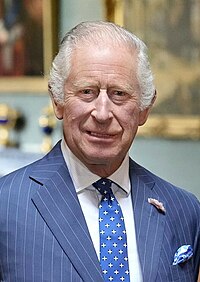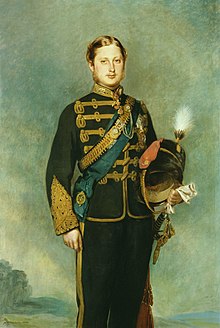Monarchy in Prince Edward Island
| King in Right of Prince Edward Island | |
|---|---|
Provincial | |
King's Arms in Right of Prince Edward Island | |
| Incumbent | |
 | |
| Charles III King of Canada since 8 September 2022 | |
| Details | |
| Style | His Majesty |
| First monarch | Victoria |
| Formation | 1 July 1873 |
By the arrangements of the
Constitutional role
The role of the Crown is both legal and practical; it functions in Prince Edward Island in the same way it does in all of Canada's other provinces, being the centre of a constitutional construct in which the institutions of government acting under the sovereign's authority share the power of the whole.[6] It is thus the foundation of the executive, legislative, and judicial branches of the province's government.[7]
The

Government House in Charlottetown is owned by the sovereign in his capacity as King in Right of Prince Edward Island and is used as an official residence by the lieutenant governor, and the monarch when in Prince Edward Island.[citation needed] It is also where the Executive Council is sworn-in and honours are given to Prince Edward Islanders.
According to the Legislative Assembly's Members' Handbook, members are not permitted to speak "disrespectfully of the Queen, the royal family, the governor general, the lieutenant governor, or the administrator of the province", as, "by their rank and position, they are entitled to respect from members." What constitutes unacceptable language "depends largely on circumstances". However, insults, obscene language, or questioning a royal or viceregal person's integrity, honesty, or character is disallowed.[12]
Royal associations
Those in the royal family
The main symbol of the monarchy is the sovereign himself, his image (in portrait or effigy) thus being used to signify government authority.
History
Foundations of the Crown in Prince Edward Island
What is today Prince Edward Island was discovered and claimed by John Cabot for King Henry VII; though, it was in 1523 also claimed by Giovanni da Verrazzano for King Francis I, putting Île Saint-Jean, as Verrazzno called it, under the sovereignty of the French Crown. As a consequence of the Acadians' refusal to swear allegiance to King George III and their subsequent expulsion from British-controlled Nova Scotia, between 1755 and 1764, Île Saint-Jean's population rose to approximately 5,000.[16]
However, these new arrivals found themselves once again under the British Crown following the signing of the 1762
During the
One of George III's sons,
The 19th century

By 1843, construction of
The Liberal Reform Party won the plurality of seats in the Legislative Assembly in 1850 and made responsible government a key goal. They faced opposition from Lieutenant Governor Ambrose Lane, but, would not relent and the legislature "virtually went 'on strike'" the following year, voting non-confidence in the Executive Council and refusing to pass supply bills. The impasse was finally overcome when the Lieutenant Governor invited George Coles to form a PEI's first responsible government.[30]
Prince Albert Edward (the future King Edward VII), the eldest son of, and heir to, Queen Victoria, landed at Charlottetown, on 10 August 1860, where he was welcomed by George Dundas, the colony's Lieutenant Governor, and proceeded to Government House. There, the Prince held audience with the Executive Council and, later, attended a formal ball and levee. Albert Edward toured the countryside and visited Province House, where he received an addresses from the Executive Council. Upon his departure, the Prince left £150 with the Governor for charitable use.[31]

The 20th and 21st centuries
Prince Albert (later King George VI) arrived on Prince Edward Island in 1913, while serving as a midshipman aboard the Royal Navy cruiser HMS Cumberland,[32] spending some leisure time coaching a cricket match.[33]
Queen Elizabeth II attended the 100th anniversary of Prince Edward Island's entry into Confederation. Her son, Prince Charles (now King Charles III), toured the island in 2014, following his son, Prince William, and William's wife, Catherine, Duchess of Cambridge, who travelled through PEI in 2011. While he was in Charlottetown, William gave a speech at Province House, standing where his ancestor, Prince Edward, had stood 151 years before, and said, "it is quite a moment for Catherine and me to be standing here in the Atlantic Canada, in front of Province House, where Canadian federation was forged [...] Here, in the crucible of Canadian nationhood, we look forward to meeting many of you."[34]

In 2022, Prince Edward Island instituted a
See also
References
- ^ Victoria (29 March 1867). Constitution Act, 1867. III.9, V.58. Westminster: Queen's Printer. Retrieved 15 January 2009.
- Elizabeth II (1985). Transboundary Pollution (Reciprocal Access) Act(PDF). 7. Charlottetown: Queen's Printer for Prince Edward Island. Retrieved 11 July 2009.
- Elizabeth II (1985). Prince Edward Island Science and Technology Corporation Act(PDF). 2.7. Charlottetown: Queen's Printer for Prince Edward Island. Retrieved 11 July 2009.
- ^ Department of Canadian Heritage (31 March 2006). "Official Languages > Canada-Prince Edward Island Agreement on French-Language Services 2005-06 to 2008-09". Queen's Printer for Canada. Retrieved 11 July 2009.
- ^ ISBN 978-0-662-46012-1. Retrieved 21 June 2009.
- ^ Cox, Noel (September 2002). "Black v Chrétien: Suing a Minister of the Crown for Abuse of Power, Misfeasance in Public Office and Negligence". Murdoch University Electronic Journal of Law. 9 (3). Perth: Murdoch University: 12. Retrieved 17 May 2009.
- ISBN 978-1-100-11096-7. Archived from the originalon 24 September 2009. Retrieved 17 May 2009.
- ^ Roberts, Edward (2009). "Ensuring Constitutional Wisdom During Unconventional Times" (PDF). Canadian Parliamentary Review. 23 (1). Ottawa: Commonwealth Parliamentary Association: 15. Archived from the original (PDF) on 26 April 2012. Retrieved 21 May 2009.
- ^ MacLeod 2008, p. 20
- ^ Victoria (26 June 1873). Prince Edward Island Terms of Union. Schedule. Westminster: Queen's Printer. Retrieved 16 June 2009.
- ISBN 978-0-7710-9773-7.
- ^ Office of the Clerk (Fall 2011), Members' Handbook (PDF), Legislative Assembly of Prince Edward Island, pp. 10, 43, retrieved 11 February 2023
- ^ Palmer, Sean; Aimers, John (2002), The Cost of Canada's Constitutional Monarchy: $1.10 per Canadian (2 ed.), Toronto: Monarchist League of Canada, archived from the original on 19 June 2008, retrieved 15 May 2009
- ^ Campbell, Duncan (1875). History of Prince Edward Island. Charlottetown: Bremner Brothers. p. 98. Retrieved 11 July 2009.
- ISBN 978-0-7712-1016-7
- ^ Lockerby, Earle (2008), Deportation of the Prince Edward Island Acadians, Nimbus Publishing, p. 7
- ^ Campbell 1875, p. 2
- ^ Campbell 1875, pp. 10–11
- ^ Campbell 1875, p. 19
- ^ Government of Prince Edward Island. "Historical Milestones". Archived from the original on 29 September 2007. Retrieved 17 August 2008.
- ^ Gwyn, Julian (2003), Frigates and Foremasts, University of British #Columbia, p. 58
- ^ "Black Loyalists in Ontario" (PDF). Retrieved 23 June 2019.
- ^ Government of Canada, Samuel Holland, Queen's Printer for Canada Archived 25 March 2007 at the Wayback Machine
- ^ Loyalist Ships, The United Empire Loyalists' Association of Canada, retrieved 31 March 2023
- ^ a b c d e f Tidridge, Nathan, Prince Edward, Duke of Kent, and the province of Prince Edward Island, The Crown in Canada, retrieved 30 March 2023
- ^ Campbell 1875, p. 54
- ^ Campbell 1875, p. 56
- ^ Campbell 1875, p. 97
- ^ Campbell 1875, p. 101
- ^ MacKinnon, Wayne (Summer 2011). "The Prince Edward Island Legislative Assembly". Canadian Parliamentary Review. Ottawa: Commonwealth Parliamentary Association. p. 9. Retrieved 11 February 2023.
- ^ Campbell 1875, pp. 128–130.
- ^ Harris, Carolyn (13 September 2022), "King George VI", The Canadian Encyclopedia, Historica Canada, retrieved 12 March 2024
- ^ Harris, Carolyn (13 September 2022), "King George VI", The Canadian Encyclopedia, Historica Canada, retrieved 12 March 2024
- ^ “At Home in Canada”: Royalty at Canada’s Historic Places, Canad's Historic Places, retrieved 30 April 2023
- ^ "Queen Elizabeth II's Platinum Jubilee Medal". princeedwardisland.ca. Retrieved 11 August 2022.
External links
- "Prince Edward visits his island". The Guardian. 12 October 2007.
- "Royal couple wraps up trip to Prince Edward Island". CBC. 10 November 2000.



